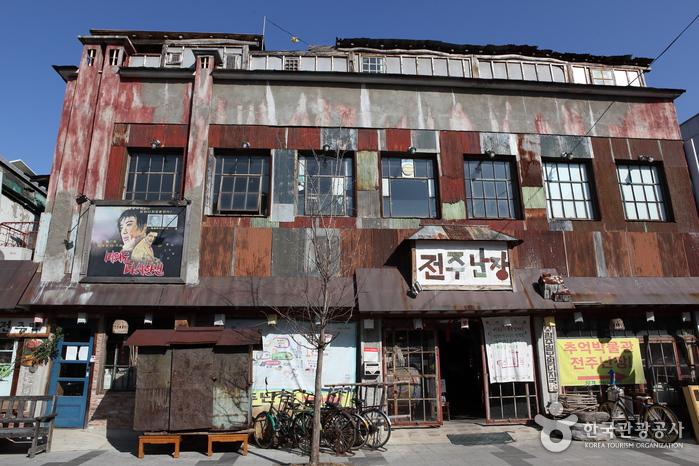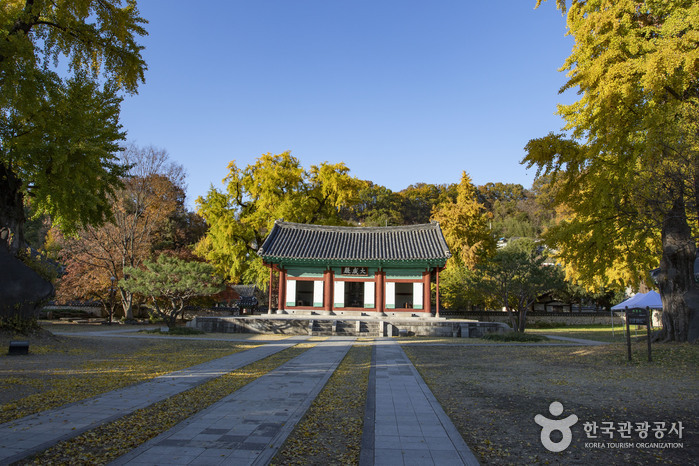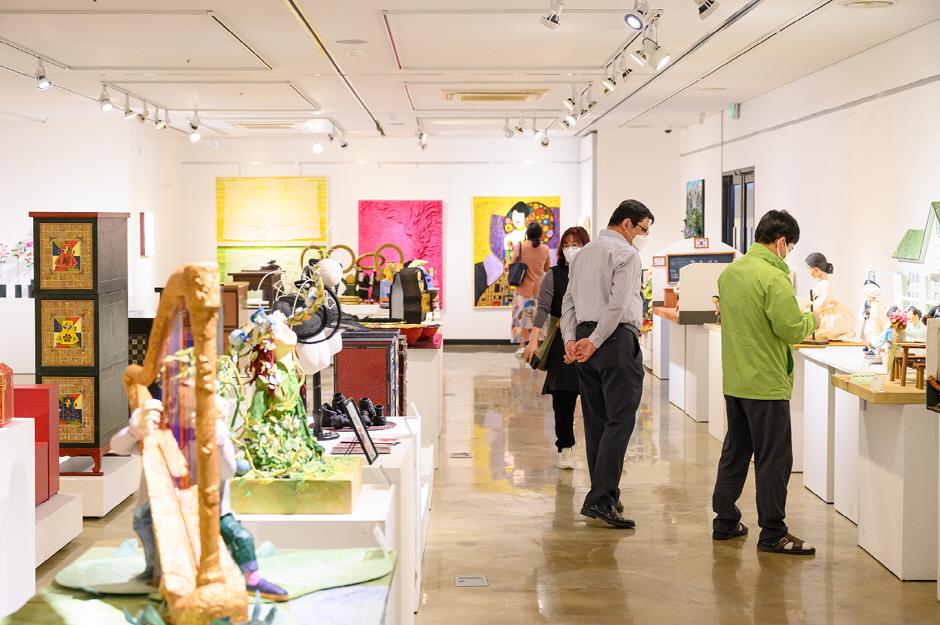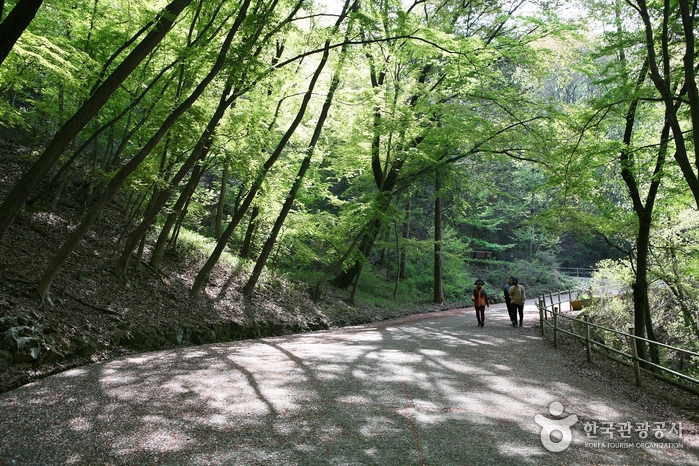Bu Yong Heon [Korea Quality] / 부용헌 [한국관광 품질인증]
863.7249535303704m 11203 2024-04-07
149-3, Hyanggyo-gil, Wansan-gu, Jeonju-si, Jeonbuk-do
+82-10-8646-0964
Buyongheon is located in Jeonju Hanok Village. Precisely speaking, Buyongheon is the very next door to Jeonju Hyanggyo (Confucian Temple and School). Across the alley are Jeonju Hyanggyo Culture Center and Wanpanbon Culture Center. If you walk a few more steps, you will reach Jeonju Hanbyeok Culture Center where you can see various performances and experience the culture and foods of Jeonju. Omokdae can be seen from the garden of Buyongheon. Across the Jeonjucheon Stream is the National Intangible Heritage Center.
The beginning of Buyongheon is deeply related with Jeonju Hyanggyo. In around 1935, the local bureaucrats lived around the Hyanggyo after building 12 houses one after another. Most of them came from rich families. These collective houses were called Buyong Houses, which meant rich houses. The name Buyongheon originated from Buyong Houses. The rooms of Buyongheon are composed of Toenmaru Bang, Daecheong Maru Bang, Large Daecheong Maru Bang and Big Sarangchae. The interior of the rooms looks neat with the beauty of blank space as they excluded unnecessary decorations. Carefully prepared breakfast is served upon request made in advance. Visitors can also experience traditional culture such as traditional etiquette education and Korean paper art.
In fall, the yellow leaves of the ginkgo tree in the garden of Jeonju Hyanggyo lights up the roof of Buyongheon. It is recommendable to walk along the Jeonjucheon Stream and take pictures of the colorful murals and the cafes in the Jaman Mural Village located on the left sie of the Hanok Village. It takes 15 minutes from Jeonju Station and 10 minutes from Jeonjuu Express Bus Terminal to Buyongheon by taxi.
Jeonju Nanjang (전주난장)
864.6708430853249m 0 2024-04-06
Dongmun-gil 33-20, Wansan-gu, Jeonju-si, Jeonbuk-do
Jeonggahanog [Korea Quality] / 정가한옥 [한국관광 품질인증]
873.6388404258478m 176 2024-04-07
78-3, Girin-daero, Wansan-gu, Jeonju-si, Jeonbuk-do
+82-10-9934-1300
Jeongga Hanok is a space where the traditional beauty of hanok and the modern comfort co-exists. The newly built Hanok is neat and pleasant. When you enter the small cobbled yard, the porch and the eaves will welcome you, and you’ll find that the rooms are filled with delicate wood fragrance. The interior is furnished with Korean cypress trees and red clay. In particular, the Cypress Tree room is all made of cypress trees, from the walls to the ceiling, making guests feel like they are lying in a forest. Maple Room and Ginkgo Tree Room, meanwhile, have attics.
Jeongga Hanok faces Jeonju Hanok Village with the Girin-daero in the middle. Hanok Village is just across the road. Major attractions such as Gyeonggijeon, Jeondong Catholic Cathedral, and Jeonjuhyanggyo Confucian School are all within walkable distance. Omokdae, which offers an unhindered view of Hanok Village, is located over the pedestrian overpass. Jaman Mural Village, famous for colorful mural and cozy cafes, is about 300 meters away and a great spot for selfie lovers.
Sky [Korea Quality] / 하늘애 [한국관광 품질인증]
893.8946973366245m 5672 2024-04-07
33-11, Dongmun-gil, Wansan-gu, Jeonju-si, Jeonbuk-do
+82-10-6453-1200
Sky is a guesthouse located in an alley next to the Jeonju Hanok Village Parking Lot. The house was built in 1930 and remodeled in 2014. It was originally a Japanese-style house, but the original building was completely demolished and a traditional Korean house was built in its place. The sheets and blankets in all the guestrooms are embroidered by the owner of the guesthouse. Her embroidery skills make some of the guests choose to stay at this guesthouse since they can learn the trade from her. She offers an embroidery class for such guests for only KRW 4,000 per person, and only 5 people are allowed in the class. If you want, you can also play the traditional Korean game called "yutnori" for free.
Dong Nak Won [Korea Quality] / 동락원 [한국관광 품질인증]
898.3147162555792m 219 2024-04-07
33-6, Eunhaeng-ro, Wansan-gu, Jeonju-si, Jeonbuk-do
+82-63-287-9300
Hanok Hotel Dongrakwon used to be a memorial hall for Missionary M. Junkin who worked in Jeonju in 1985, and had long been used as an official residence for the Bank of Korea. The 100-year-old Hanok retains the history and culture that modern hotels do not have. Since the renovation to make it a hanok hotel, it is now utilized as a space for traditional music performances, traditional weddings, or small weddings. The entire building can be rented for various gatherings, seminars, conferences, family events, and so on. The beauty of a hanok is found in every corner of Dongrakwon such as the wide lawn, the pond in front of Sarangchae, and the jar stand next to Anchae. The antique furniture and folding screen in the rooms have been used for generations, enabling guests of the hanok to time travel to 50-100 years ago.
The yard is a great place to play simple Korean traditional plays such as Jegichagi and Dakjichiji, whereas the free-of-charge red clay sauna will relieve fatigue. The outdoor hot / cold bath and sun bath site is a new addition to Dongrakwon.
There is a 600-year-old Ginkgo tree standing on the Eunhang-ro, where the accommodation is located. Opposite the alley is Donghak Revolution Memorial Exhibition Hall; Gyeonggijeon East Gate is 200m away. The hotel is close to Taejo-ro, the busiest street of Jeonju Hanok Village; neighboring Eunhang-ro, Choi Myeong Hee-gil, and Eojin-gil all retain the unique quietness and beauty of Hanok Village. It will be also nice to ride on the mountain bike that Dongrakwon offers free of charge in order for guests to visit corners of the Hanok Village, or ride along the Jeonjucheon Stream.
Aldea Tradicional de Jeonju (Cittaslow) (전주한옥마을 [슬로시티])
908.3403232708512m 14189 2024-04-06
Girin-daero 99, Wansan-gu, Jeonju-si, Jeonbuk-do.
La Aldea Tradicional de Jeonju (Hanok Maeul) está ubicada en las zonas de Pungnam-dong y Gyo-dong. En esta área se encuentran concentradas aproximadamente 800 casas tradicionales de Corea, las hanok. Este lugar es famoso por conservar intacto el estilo tradicional, proporcionando la oportunidad de disfrutar el ambiente antiguo y folclórico del país.
Lo más elegante de esta aldea es seguramente el estilo de los techos de las hanok. La peculiaridad de esta vivienda es que el borde de los techos está ligeramente dirigido hacia el cielo. La estructura de estas casas se divide en dos secciones: anchae y sarangchae. Anchae, siendo el lugar donde permanecen las mujeres, también es llamado gyusubang; mientras que el sarangchae es el lugar utilizado por los hombres, también llamado seonbibang. La construcción arquitectónica diferencia el sector destinado a los hombres y mujeres. De tal manera, el anchae, por ser el lugar donde residen las mujeres, se localiza en la parte más resguardada y silenciosa de la casa.
Otra característica es que los cuartos son de ondol, un sistema de calefacción instalado en el suelo. La estructura del ondol es bastante simple, consiste en aplicar el sistema de calefacción debajo del piso, con pasajes horizontales para el humo y una chimenea vertical para el escape. Una de las grandes ventajas es que en verano es fresco y en invierno, caliente.
Además de los recorridos, observando la sabiduría y las costumbres tradicionales de la antigüedad, otro de los atractivos lo componen las actividades culturales que consisten en experimentar las habitaciones de ondol y degustar del plato típico famoso de la ciudad, el bibimbap (arroz mezclado con surtido de vegetales).
Inyeon Hanok [Korea Quality] / 인연 [한국관광 품질인증]
913.6185499816825m 4407 2024-04-07
36, Hanji-gil, Wansan-gu, Jeonju-si, Jeonbuk-do
+82-10-2908-4965
The Korea's largest "hanok (traditional Korean house)" village in the middle of Jeonju, Jeollabuk-do has been there for hundreds of years. Today, you can see new as well as old houses there. “Inyeon” is one of the traditional Korean houses located near the public parking lot on the outskirts of the hanok village, making it a great place to stay overnight in quiet. The word "inyeon" means "relationship" in Korean, referring to all types of ties with other people. The owner of the guesthouse named the place as such because she is greatful for all the guests and wanted to treat them well. She opened the guesthouse in September 2014. Since then, she has been kind enough to tell her guests which places are good to visit and which foods are delicious. She makes sure all the facilities including sheets and blankets are maintained clean for her guests to have a memorable stay. Built in the 1960's and remodeled in 2008, the traditional house is neat with most of the traditional features. It has four guestrooms named "Apricot Flower", "Orchid", "Chrysenthemum", and "Bamboo". The "Orchid Room" and "Bamboo Room" can accommodate up to seven people. The floor is covered with lacquered traditional Korean paper, and there are a number of traditional items in the room including the Korean gong. The traditional Korean ceiling rafters are visible in all the rooms.
All the rooms are furnished with a bathroom, air conditioner, TV, refrigerator, toiletries, and hair dryer. There is a 200-year-old pomegranate tree in the yard, and a table and chairs right in front of it for the guests to relax on a fair day. The table made of an old door and chairs made of a log under the red pomegranates are one of the most outstanding features of this guesthouse. There are lots of traditional items in the yard with which you can play traditional Korean games such as "yutnori" and "jegichagi", all of which can be used by the guests for free.
Escuela Confuciana Jeonju Hyanggyo (전주향교)
943.6164131854123m 4530 2024-04-07
Hyanggyo-gil 139, Wansan-gu, Jeonju-si, Jeonbuk-do.
Es una escuela confuciana que fue fundada en la dinastía de Joseon (1392-1910) y fue designada como Tesoro Histórico Nº 379. Fue un establecimiento educativo del período de Joseon que estuvo originariamente ubicado en el sitio del santuario Gyeonggijeon, pero fue relocalizado en este lugar en 1603. Las tablillas mortuorias de 7 eruditos confucianos chinos y los 18 eruditos coreanos están conservadas en el edificio principal llamado Daeseongjeon.
Festival Cultural del Hanji de Jeonju (전주한지문화축제)
948.8150170679078m 1722 2024-04-06
Hyeonmu 1-gil 20, Wansan-gu, Jeonju-si, Jeonbuk-do
063-281-1574
Este festival tiene la visión de enfocar la utilidad del papel tradicional coreano hanji en la vida cotidiana y, de esta manera, lograr su comercialización, reunir las estrategias para su desarrollo sistematizado y asentar las bases para convertirlo en uno de los productos estratégicos principales de Corea.
Pico Wansanchilbong (Parque Wansan) (완산칠봉(완산공원))
1.0 Km 27963 2024-04-06
Gongsunae 1-gil 19-4, Wansan-gu, Jeonju-si, Jeonbuk-do
+82-63-220-5438
El pico Wansanchilbong se encuentra al sur de las afueras de Jeonju. Hay un pabellón ubicado en la parte superior donde las personas pueden observar la zona. Todo el monte, designado como Parque Wansan, está protegido por el Ayuntamiento de Jeonju. Es un refugio popular para los lugareños, especialmente en primavera, cuando los árboles están en plena floración bordeando los senderos.
![Bu Yong Heon [Korea Quality] / 부용헌 [한국관광 품질인증]](http://tong.visitkorea.or.kr/cms/resource/94/2596794_image2_1.jpg)

![Jeonggahanog [Korea Quality] / 정가한옥 [한국관광 품질인증]](http://tong.visitkorea.or.kr/cms/resource/62/2594362_image2_1.jpg)
![Sky [Korea Quality] / 하늘애 [한국관광 품질인증]](http://tong.visitkorea.or.kr/cms/resource/39/2046939_image2_1.jpg)
![Dong Nak Won [Korea Quality] / 동락원 [한국관광 품질인증]](http://tong.visitkorea.or.kr/cms/resource/16/2595016_image2_1.jpg)

![Inyeon Hanok [Korea Quality] / 인연 [한국관광 품질인증]](http://tong.visitkorea.or.kr/cms/resource/21/2583721_image2_1.jpg)



 Español
Español
 한국어
한국어 English
English 日本語
日本語 中文(简体)
中文(简体) Deutsch
Deutsch Français
Français Русский
Русский